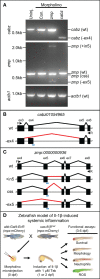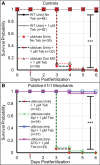Functional identification of the zebrafish Interleukin-1 receptor in an embryonic model of Il-1β-induced systemic inflammation - PubMed
- ️Sat Jan 01 2022
Functional identification of the zebrafish Interleukin-1 receptor in an embryonic model of Il-1β-induced systemic inflammation
Dylan J Sebo et al. Front Immunol. 2022.
Abstract
Interleukin-1β (IL-1β) is a potent proinflammatory cytokine that plays a vital role in the innate immune system. To observe the innate immune response in vivo, several transgenic zebrafish lines have been developed to model IL-1β-induced inflammation and to visualize immune cell migration and proliferation in real time. However, our understanding of the IL-1β response in zebrafish is limited due to an incomplete genome annotation and a lack of functional data for the cytokine receptors involved in the inflammatory process. Here, we use a combination of database mining, genetic analyses, and functional assays to identify zebrafish Interleukin-1 receptor, type 1 (Il1r1). We identified putative zebrafish il1r1 candidate genes that encode proteins with predicted structures similar to human IL1R1. To examine functionality of these candidates, we designed highly effective morpholinos to disrupt gene expression in a zebrafish model of embryonic Il-1β-induced systemic inflammation. In this double transgenic model, ubb:Gal4-EcR, uas:il1βmat , the zebrafish ubiquitin b (ubb) promoter drives expression of the modified Gal4 transcription factor fused to the ecdysone receptor (EcR), which in turn drives the tightly-regulated expression and secretion of mature Il-1β only in the presence of the ecdysone analog tebufenozide (Teb). Application of Teb to ubb:Gal4-EcR, uas:il1βmat embryos causes premature death, fin degradation, substantial neutrophil expansion, and generation of reactive oxygen species (ROS). To rescue these deleterious phenotypes, we injected ubb:Gal4-EcR, uas:il1βmat embryos with putative il1r1 morpholinos and found that knockdown of only one candidate gene prevented the adverse effects caused by Il-1β. Mosaic knockout of il1r1 using the CRISPR/Cas9 system phenocopied these results. Taken together, our study identifies the functional zebrafish Il1r1 utilizing a genetic model of Il-1β-induced inflammation and provides valuable new insights to study inflammatory conditions specifically driven by Il-1β or related to Il1r1 function in zebrafish.
Keywords: ROS - reactive oxygen species; UAS/Gal4; inflammation; interleukin - 1 β; interleukin 1 receptor type 1; neutrophils; zebrafish.
Copyright © 2022 Sebo, Fetsko, Phipps and Taylor.
Conflict of interest statement
The authors declare that the research was conducted in the absence of any commercial or financial relationships that could be construed as a potential conflict of interest.
Figures

In silico identification of the putative zebrafish interleukin-1 receptor, type 1 (Il1r1). (A) Alignment of human, mouse, and zebrafish genomic regions showing conserved synteny. Shown here are the human and mouse IL-1 receptor clusters and the putative zebrafish IL-1 receptor cluster (not to scale). (B) Phylogenetic alignment of human IL1R protein sequences with putative zebrafish Il1r protein sequences. (C) Predicted protein structures of human IL1R1, zebrafish CABZ (CABZ01054965), and zebrafish ZMP (ZMP:0000000936) showing conserved domains: N-terminal signal peptide (SP), 3 extracellular immunoglobulin-like (Ig-l) domains (Ig-l 1, Ig-l 2, and Ig-l 3), a single transmembrane domain (TM), and an intracellular Toll/Interleukin-1 receptor (TIR).

Developmental expression of putative zebrafish Il1r1. (A) RT-PCR from WT embryos at 0-3 dpf showed expression of cabz beginning at 1 dpf, maternal expression of zmp at 0 dpf, and actin beta 1 (actb1) transcript as an experimental control. Molecular weight markers are shown on the right. (B) Whole-mount in situ hybridization using antisense DIG-labeled riboprobes against cabz or zmp transcripts showed unrestricted expression of both transcripts at 1, 2, and 3 dpf. Scale bar in (B) is 200 µm.

Morpholino knockdown of putative zebrafish Il1r1. (A) RT-PCR of cabz, zmp, and actb1 transcripts from uninjected embryos, control morpholino injected embryos, and cabz and zmp morphants. (B) Schematic of the cabz01054965 (cabz) gene showing exons 3-6, forward (F) and reverse (R) primers used for analysis (black arrowheads), the location of the splice donor site morpholino (blue line), normal splicing of wt (black lines), and aberrant splicing with the cabz morpholino (red line) that excludes exon 4 (-ex4). (C) Schematic of the zmp:0000000936 (zmp) gene showing exons 4-8, forward (F) and reverse (R) primers used for analysis (black arrowheads), the location of the splice donor site morpholino (blue line), normal splicing of wt (black lines), and aberrant splicing with the zmp morpholino (red lines) that includes intron 5 (+in5), introduce a cryptic splice sites (css), or excludes exon 5 (-ex5). (D) Diagram of the experimental paradigm used to functionally identify zebrafish Il1r1. A zebrafish model of Il-1β-induced systemic inflammation was generated by breeding transgenic lines ubb:Gal4-EcR and uas:Ilβmat with or without the neutrophil reporter line mpx:mCherry. Single-celled embryos were injected with morpholino, inflammation was induced with 1 µM Tebufenozide (Teb) at 1 or 2 dpf, and functional analyses were performed from 3-6 dpf to assess morpholino rescue of Il-1β-induced inflammation.

Survival analysis of Il-1β-induced mortality. (A) Kaplan-Meier representations of the survival of WT larvae left untreated (WT Uninj No Teb), or Teb treated (WT Uninj + 1 µM Teb), ubb:Gal4-EcR, uas:Ilβmat larvae with no Teb treatment (ubb/uas Uninj No Teb), with Teb (ubb/uas Uninj + 1 µM Teb), or injected with control morpholino with Teb (ubb/uas Con MO + 1 µM Teb). (B) Kaplan-Meier representations of the survival of ubb:Gal4-EcR, uas:Ilβmat larvae left uninjected with teb treatment (ubb/uas Uninj + 1 µM Teb) injected with the cabz splice donor morpholino with Teb (ubb/uas cabz Spl + 1 µM Teb), zmp splice donor morpholino with Teb (ubb/uas zmp Spl + 1 µ M Teb), or zmp start site morpholino with Teb (ubb/uas zmp ATG + 1 µM Teb). Teb was added to the embryos at 1 dpf (red arrowhead). Note that only the zmp morpholinos rescued Il-1β-induced death. ***p<0.001.

Gross morphological analysis of Il-1β-induced morbidity. (A) Representative images of ubb:Gal4-EcR, uas:Ilβmat larvae showing gross morphology. Shown here are uninjected larvae, cabz morphants, and zmp morphants without Teb (No Teb) and with Teb treatment (+Teb). Note that zmp morphants +Teb showed normal morphology with no gross defects. (B–D) Mean Cross-Sectional Fin Area (B), Body Area (C), and the product of Body Area – Fin Area (D) was plotted in mm2 for each group. Error Bars are +1 standard deviation. Asterisks indicate significant differences *p < 0.05 **p < 0.01 ***p < 0.001; N.S., not significant; by one-way ANOVA followed by Tukey’s HSD Test. Scale bar in (A) is 1 mm.

Il-1β-induced neutrophil recruitment. (A) Representative confocal images of ubb:Gal4-EcR, uas:Ilβmat, mpx:mCherry larvae. Shown here are uninjected larvae, cabz morphants, and zmp morphants without Teb (No Teb) and with Teb treatment (+Teb). (B) Neutrophils were counted using FIJI Cell Counter and Total Neutrophil counts were plotted for each group. Error Bars are +1 standard deviation. Asterisks indicate significant differences *p < 0.05 **p < 0.01; N.S., not significant; by one-way ANOVA followed by Tukey’s HSD Test. Scale bar in (A) is 1 mm.

Analysis of Reactive Oxygen Species in Il-1β-induced inflammation. (A) Representative confocal images of ubb:Gal4-EcR, uas:Ilβmat larvae treated with CM-H2DCFDA. Shown here are the overlay of brightfield and CM-H2DCFDA fluorescence (left panels) and CM-H2DCFDA fluorescence only (right panels). Fluorescence signal was quantified from the region of interest outlined with a white border in the CM-H2DCFDA images. (B) Relative Fluorescence Intensity (RFI) was quantified using FIJI ‘mean grey value’ measurement. All mean RFIs were normalized to uninjected No Teb mean values. Error Bars are +1 standard deviation. Asterisks indicate significant differences **p < 0.01 ***p < 0.001 by one-way ANOVA followed by Tukey’s HSD Test. Scale bar in (A) is 1 mm.
Similar articles
-
Genetically inducible and reversible zebrafish model of systemic inflammation.
Lanham KA, Nedden ML, Wise VE, Taylor MR. Lanham KA, et al. Biol Open. 2022 Mar 15;11(3):bio058559. doi: 10.1242/bio.058559. Epub 2022 Mar 9. Biol Open. 2022. PMID: 35099005 Free PMC article.
-
Genetic and Epigenetic Regulation of the Innate Immune Response to Gout.
de Lima JD, de Paula AGP, Yuasa BS, de Souza Smanioto CC, da Cruz Silva MC, Dos Santos PI, Prado KB, Winter Boldt AB, Braga TT. de Lima JD, et al. Immunol Invest. 2023 Apr;52(3):364-397. doi: 10.1080/08820139.2023.2168554. Epub 2023 Feb 6. Immunol Invest. 2023. PMID: 36745138 Review.
-
Yan B, Han P, Pan L, Lu W, Xiong J, Zhang M, Zhang W, Li L, Wen Z. Yan B, et al. J Immunol. 2014 Jun 15;192(12):5998-6008. doi: 10.4049/jimmunol.1301645. Epub 2014 May 16. J Immunol. 2014. PMID: 24835391
-
Lappano R, Talia M, Cirillo F, Rigiracciolo DC, Scordamaglia D, Guzzi R, Miglietta AM, De Francesco EM, Belfiore A, Sims AH, Maggiolini M. Lappano R, et al. J Exp Clin Cancer Res. 2020 Aug 10;39(1):153. doi: 10.1186/s13046-020-01667-y. J Exp Clin Cancer Res. 2020. PMID: 32778144 Free PMC article.
-
Kawakami K, Asakawa K, Hibi M, Itoh M, Muto A, Wada H. Kawakami K, et al. Adv Genet. 2016;95:65-87. doi: 10.1016/bs.adgen.2016.04.002. Epub 2016 Jun 13. Adv Genet. 2016. PMID: 27503354 Review.
Cited by
-
Lunar-linked biological rhythms in the immune system of freshwater three-spined stickleback.
Jackson JA, Stewart A, Cable J. Jackson JA, et al. Discov Immunol. 2024 May 25;3(1):kyae007. doi: 10.1093/discim/kyae007. eCollection 2024. Discov Immunol. 2024. PMID: 38863794 Free PMC article.
-
Unexpected regulatory functions of cyprinid Viperin on inflammation and metabolism.
Chaumont L, Jouneau L, Huetz F, van Muilekom DR, Peruzzi M, Raffy C, Le Hir J, Minke J, Boudinot P, Collet B. Chaumont L, et al. BMC Genomics. 2024 Jun 29;25(1):650. doi: 10.1186/s12864-024-10566-x. BMC Genomics. 2024. PMID: 38951796 Free PMC article.
-
Inflammation in Development and Aging: Insights from the Zebrafish Model.
Mastrogiovanni M, Martínez-Navarro FJ, Bowman TV, Cayuela ML. Mastrogiovanni M, et al. Int J Mol Sci. 2024 Feb 10;25(4):2145. doi: 10.3390/ijms25042145. Int J Mol Sci. 2024. PMID: 38396822 Free PMC article. Review.
-
Fetsko AR, Sebo DJ, Budzynski LB, Scharbarth A, Taylor MR. Fetsko AR, et al. iScience. 2024 Mar 30;27(5):109651. doi: 10.1016/j.isci.2024.109651. eCollection 2024 May 17. iScience. 2024. PMID: 38638574 Free PMC article.
References
-
- Yan B, Han P, Pan L, Lu W, Xiong J, Zhang M, et al. . IL-1beta and reactive oxygen species differentially regulate neutrophil directional migration and basal random motility in a zebrafish injury-induced inflammation model. J Immunol (2014) 192(12):5998–6008. doi: 10.4049/jimmunol.1301645 - DOI - PubMed
Publication types
MeSH terms
Substances
LinkOut - more resources
Full Text Sources
Molecular Biology Databases